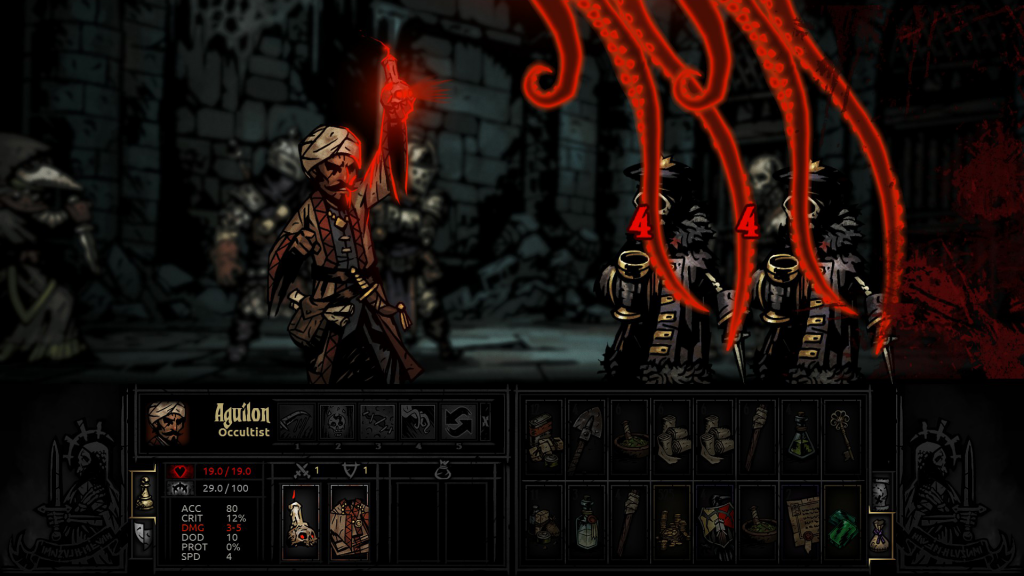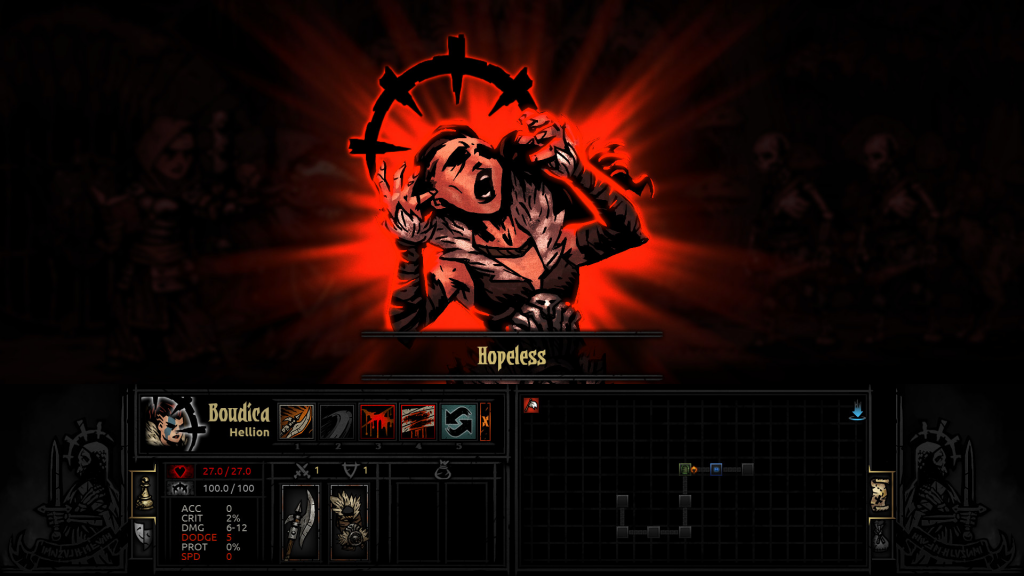Reynauld, a noble knight and my trustiest warrior, speaks to me before we embark on our latest doomed quest in Darkest Dungeon. “I need a break… but I suppose I could do one more”. Reynauld is essential. He tanks damage, deals massive amounts in return, heals himself and keeps morale high. He’s the most upgraded hero in the group – I’m not going back into the ruins without him. All seems well until we reach the final room of the gloomy dungeon. The party is stressed. They’ve been victims of various poisons, grievous wounds, and near death experiences. They’ve seen unspeakable horrors and dragged each other out of grim ends. We ran out of food and torches one too many rooms ago. Halfway through the last fight, the group is on the verge of breaking.
Last time this happened, Reynauld saved the day. His resolve was tested and he emerged victorious, defeating the remaining undead with a valiant war cry that steeled his allies.
Swords, spells, dangling astral appendages. All in a night’s work.
This time was different. Reynauld snapped and became masochistic. Every time he suffered another blow the crazed knight would spout nonsense about every righteous man bearing scars, and it unsettled the rest of the party almost to the point of scattering. He wouldn’t move from the front lines even when his wounds demanded retreat. My greatest ally refused the occultist’s dubious healing magic and carved a bloody swath through the cultists before him, screaming obscenity with every strike he took.
We won the day by a thread. But at what cost? On our return to town, I dropped Reynauld off at the abbey for a week of penance through flagellation. And back into the fray my tenuous group of graverobbers, plague doctors and highwaymen went.
Darkest Dungeon warns you at the beginning that this isn’t your standard RPG. Quests will fail. Heroes will die -forever- taking all their hard-earned experience and equipment with them. There are consequences for everything. You will lose a party member that’s been with you for hours upon hours of gruelling dungeon crawling to poison, bleeding, traps and madness. Every boon you find, every upgrade you buy with bloodied coin – all it does is stave off their inevitable brutal demise.

As you trudge through pitch-black corridors and arcane catacombs fighting all manner of eldritch terrors, the things your party sees will slowly push them towards losing their minds. This is a brilliant mechanic, executed with even more finesse and depth than the Sanity Meter in cult classic Eternal Darkness: Sanity’s Requiem. The more stress a character is under, the more likely they are to have their resolve tested, and from there it’s just down to the toss of a coin on whether they’ll come out stronger or lose their minds entirely. The challenges they face shape them, inducing quirks that change their behaviour. See something horrible? A pious character might become Faithless, no longer able to gain peace through activities at the Abbey. Push a character too far and they become unreliable, nervous wrecks whose only comfort is excessive drinking. I once left Dismas, one of my most powerful highwaymen, at a brothel, only for him to disappear for a couple of weeks seeking the pleasures of the flesh. Shortly after his return, I discovered he had developed the Deviant Tastes quirk and was now barred from the brothel for reasons I don’t really want to know. It’s easily Darkest Dungeon’s most unique feature. Unpredictable, volatile chaos, hounding the party in the caverns they plunder and even the things they do to unwind after they’ve been through the meat grinder.
Combat is turn-based but the addition of Stress and Quirks make it anything but predictable.
It’s brilliant. There’s no other word for it. You can’t just find one combination of heroes and abilities that work for you and spam it to success. What usually leads you to victory will drop you into horrible, gory failure. You have to rotate your roster of hired help constantly, taking new, untested recruits into battle instead of your favourites. Daunger needs a night out on the town otherwise she might break and refuse to heal your party at the worst possible moment. If Baliol doesn’t get to spend some time gambling or he just might have a heart attack next time some massive tentacle assails him. Even if you’re diligent in keeping your heroes well-rested and relaxed between expeditions, it’s entirely possible for them to go through enough in just a few encounters to send them over the edge, and this is where Darkest Dungeon’s genius really shines (as much as it can through all the entrails and cobwebs).
The visuals are spectacular. Hellboy artist Mike Mignola is a clear inspiration on pretty much every screen, drenched in grim embellishments and bloody detail. The characters and monsters truly come to life through some masterful artwork, positively squelching with Lovecraftian influence as they maul, wail and bleed their way to various tragic demises in this gloriously twisted adventure. Environments are varied, each more insidious and surprising than the last, monsters go from shambling undead and vicious bandits to shambling cosmic monstrosities but they all look unique and inspired. Nothing has been held back and it shows – a game with such rich and rewarding core mechanics could easily coast by with average 2D graphics and still be adored, but Darkest Dungeon goes the extra mile, and then some. There’s a lot of fun in the traps, challenges and stress-management elements of the game, but the spectacular artwork is what will stay with me long after I’m done playing.

When party members break it more often than not spells doom for the whole group.
Story – or what could be considered the primary motivation for all these people to voluntarily be in this terrible place all at once – is a classic gothic yarn involving a relative delving too deep into the secrets of your ancestral home, uncovering a portal to a maddening hellscape and potentially dooming mankind. It’s well told through voice-over and animated scenes but ultimately takes second place next to the ongoing, random narrative that develops between your characters as they suffer. It’s not threadbare or hollow, provided in just the right amount to give you context and motivation whilst not weighing down the gameplay as it mercilessly forges ahead. Yeah, redeeming your family name and potentially saving the world is important, but there could be a lot of a treasure in that next room and I’m sure we can go one more round without food or rest. My healer might be clawing at the walls and the tank is considering eating the paranoid plague doctor but loot.
Attacks on sanity cause the turn-based combat to shift and writhe from the plodding tactical pace of other such games to something otherworldly, whereas healing and buffing is most definitely a concern the addition of the stress meter, something that’s always rising as you explore, causes priorities to shift dramatically. Heal the slipping crusader might save him from a final death blow, but restoring his sanity and taking a chance on his physical wellbeing could well save the entire party. It’s not all doom and gloom, though. Landing critical strikes, claiming treasures and victories, downing foes – all these and more embolden your party as they take pride in their success and find the strength to keep going. The 2D motley crue of rogues and heroes are far, far more genuinely human than any character from your AAA game of choice, despairing and developing weaknesses as they fail, fearing the tremendous amounts of evil they face, and bolstering each other when they find the courage to do so.
There are rare moments of respite. Camps give the party the chance to rest and recuperate, applying buffs and stress-relieving abilities as you hunker down by a fading fire.
There’s nothing quite like Darkest Dungeon’s wicked blend of crimson-soaked art, tactical gameplay and dark humour. It’ll kill everything you love, erase hours of hard work for stupid mistakes, and you’ll keep coming back for more. How far can you push the party before they break? Are you prepared to lose everything for an ultimately vague and probably painful reward? Find out just how dark the Darkest Dungeon can get. It just might be one of the best experiences of your gaming life.
Darkest Dungeon TL;DR:
- Extremely unpredictable, addictive turn-based combat and exploration that constantly changes as characters go mad, develop personality quirks and fears, or find hidden strengths.
- A lavish gothic world flavoured with captivating Hellboy inspired artwork and Lovecraftian horrors.
- Deep risk vs. reward treasure hunting. Success costs sanity and every point of health and stress count.
- Not a game for the easily frustrated or squeamish constitutions. After your first few hours with the game, every step becomes a measured risk and the challenge could be offputting to some.
98%
Darkest Dungeon is developed by Red Hook studios and is available on PC, PS4 and PSvita.
You can also check out more of our reviews by clicking HERE.
3 comments
Such an awesome game. One day I may even beat a level 2 dungeon quest. Shit, maybe even keep a fella alive for more than a few delves into the dark.
It’s up there as one of my favourite games. The layout of the challenge is perfect. Keeps you coming back for more even as you lose your favourite characters and hours of progress.
[…] few honourable mentions: Darkest Dungeon is probably one of the greatest RPGs I’ve ever played and you should definitely go get […]